
NP100 Edition 9 2009
.pdf
Contents
LAWS AND REGULATIONS APPERTAINING TO NAVIGATION
While, in the interests of safety of shipping, the United Kingdom Hydrographic Office makes every endeavour to include in its hydrographic publications details of the laws and regulations of all countries appertaining to navigation, it must be understood:
(a)that no liability whatever will be accepted for failure to publish details of any particular law or regulation, and
(b)that publication of the details of a law or regulation is solely for the safety and convenience of shipping and implies no recognition of
the international validity of the law or regulation.
NP 100
Extracts from
THE MARINER’S
HANDBOOK
NINTH EDITION 2009
Edition 1.1 – December 2009
USING THIS DOCUMENT
This Adobe Acrobat Portable Document Format (PDF) document is mainly intended to be used on–screen, although a single copy may be printed out for personal use.
The document has been optimised for on–screen use by the inclusion of bookmarks. Click the bookmarks tab in Adobe Acrobat Reader to use this facility.
Users’ attention is drawn to the information contained within the introduction on page 11.
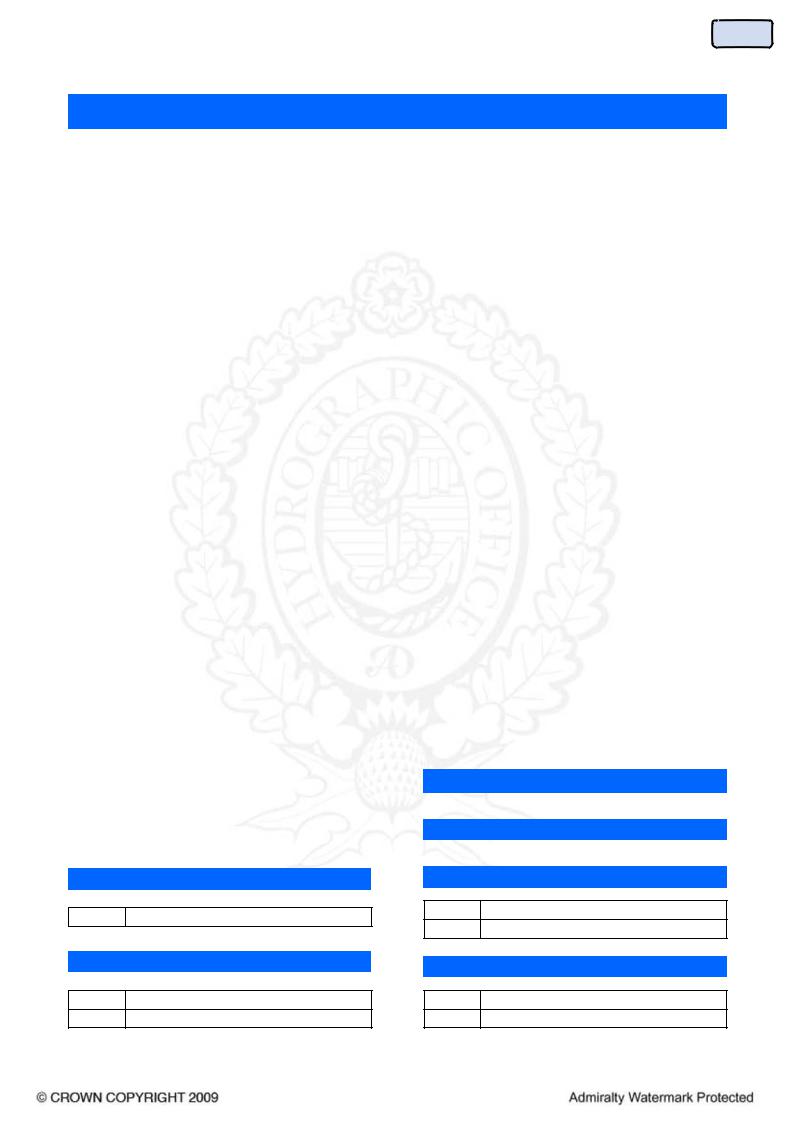
Contents
LIST OF CONTENTS
This document contains extracts from the Mariner’s Handbook, 9th Edition (2009).
Chapters, sections and paragraphs of the book which are not included in this extract are listed in blue type for information. Mariners who require this information should consult the paper publication.
|
Chapter 1 – The UKHO, |
|
|
surveying and charting |
|
|
|
|
|
Surveying |
|
|
|
|
|
Data quality |
|
|
|
|
1.1 – |
See NP 100 |
|
1.4 |
|
|
|
|
|
1.5 |
Charted depths |
|
|
|
|
1.6 |
Use of source diagrams |
|
|
|
|
1.7–1.8 |
CATZOC |
|
|
|
|
1.9 |
Scale of survey |
|
|
|
|
1.10 |
Date of Survey |
|
|
|
|
|
Sounding methods |
|
|
|
|
1.11 |
General information |
|
|
|
|
1.12 |
Lead line |
|
|
|
|
1.13 |
Single beam echo sounder |
|
|
|
|
1.14 |
Swathe echo sounder |
|
|
|
|
1.15 |
LIDAR |
|
|
|
|
1.16 |
Wire sweep or wire drag |
|
|
|
|
1.17 |
Side–scan sonar |
|
|
|
|
|
|
|
|
Fixing methods |
|
|
|
|
1.18 |
Angles to local landmarks |
|
|
|
|
1.19 |
Electronic position fixing |
|
|
|
|
1.20 |
Satellite position fixing |
|
|
|
|
Depths
1.21Accuracy and quality of information
Seabed
1.22Nature of the seabed
1.23Areas of mobile seabed
|
Charting |
|
|
|
|
|
Navigational information |
|
|
|
|
1.24 |
Use of information received |
|
|
|
|
1.25 |
Disclaimer |
|
|
|
|
1.26 |
Digital products |
|
|
|
|
1.27 |
Software |
|
|
|
|
|
|
|
|
Methods and standards |
|
|
|
|
1.28 |
Scale |
|
|
|
|
1.29 |
Scale accuracy |
|
|
|
|
1.30 |
Chart datums and the accuracy of charted |
|
|
positions |
|
1.31 |
Surveying |
|
|
|
|
1.32 |
Chart compilation |
|
|
|
|
1.33 |
Positions from satellite navigation systems |
|
|
|
|
1.34 |
Differential Global Positioning System |
|
|
(DGPS) |
|
1.35 |
Graduations on plans |
|
|
|
|
1.36 |
Distortion of charts |
|
|
|
|
1.37 |
Ocean charting |
|
|
|
|
1.38 |
Depth criteria for wrecks |
|
|
|
|
Chapter 2 – Admiralty Charts
General information
Use of the most appropriate chart
2.1General information
2.2Scale
Accuracy and reliability
2.3 Reliance on charts
2.4 Assessing the reliability of a chart
2
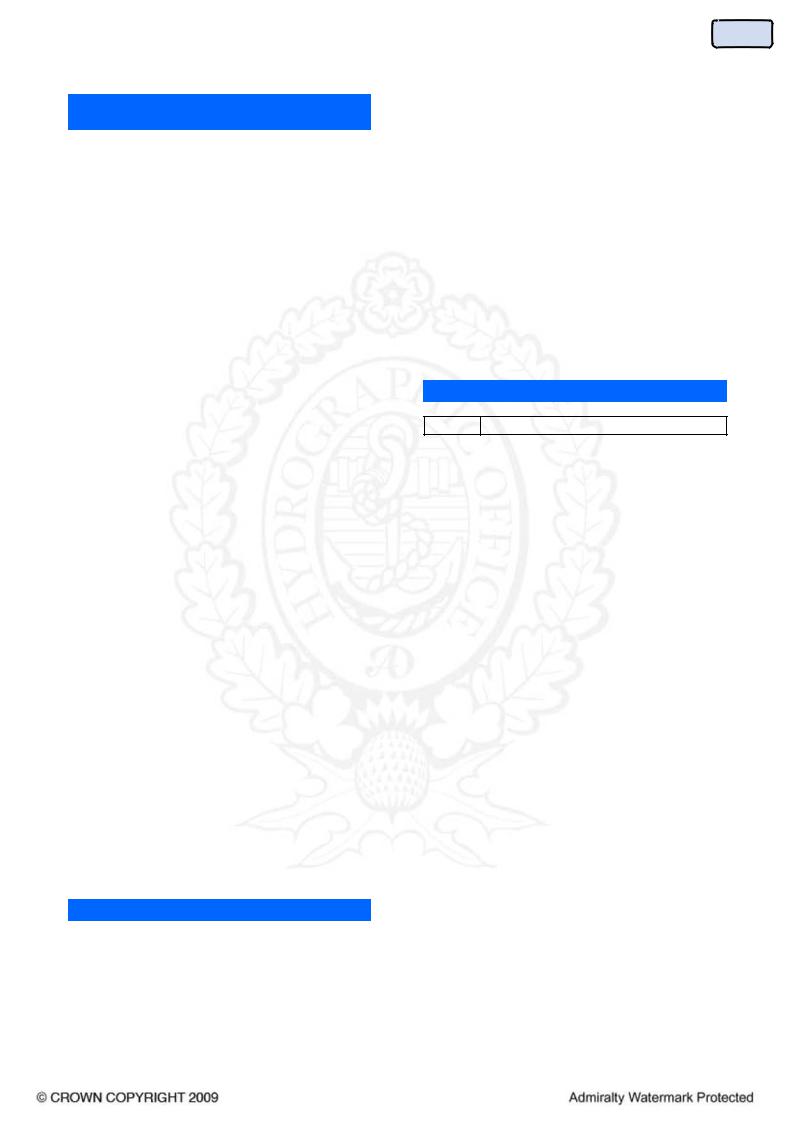
Contents
LIST OF CONTENTS
Horizontal datums on charts and satellite derived positions
|
General information |
|
|
|
|
2.5 |
Definition of a horizontal datum |
|
|
|
|
2.6 |
Background |
|
|
|
|
|
History of datums |
|
|
|
|
2.7– |
See NP 100 |
|
2.10 |
|
|
|
|
|
|
Datums in worldwide use |
|
|
|
|
2.11 |
Adoption of WGS84 |
|
|
|
|
2.12 |
Undetermined datums |
|
|
|
|
2.13 |
Effect of using different datums |
|
|
|
|
2.14 |
Datum differences |
|
|
|
|
2.15 |
Transferring positions between charts |
|
|
|
|
2.16 |
Charts of the British Isles |
|
|
|
|
2.17 |
Reporting differences between observed |
|
|
and charted positions |
|
|
|
|
|
Chart datums and GNSS |
|
|
|
|
2.18 |
Datums used by GNSS |
|
|
|
|
2.19 |
Relating the position of a point to WGS84 |
|
|
|
|
2.20 |
Applying corrections |
|
|
|
|
2.21 |
Scale of chart and plotting accuracy |
|
|
|
|
2.22 |
GPS receivers with built–in datum |
|
|
correction |
|
|
|
|
2.23 |
Regional datums and datums used on |
|
|
charts |
|
2.24 |
Survey accuracy in relation to positional |
|
|
accuracy of GNSS |
|
|
|
|
2.25 |
Differences in position caused by different |
|
|
methods of transformation |
|
Datums in electronic charting systems
2.26 |
General information |
|
|
2.27 |
Admiralty Raster Chart System (ARCS) |
|
|
2.28 |
Electronic Navigational Charts (ENCs) |
|
|
2.29 |
Other electronic chart data |
|
|
2.30 |
GPS input to ECS/ECDIS |
|
|
|
|
Paper charts and diagrams |
|
|
|
|
|
|
Charts of the Admiralty series |
|
|
|
|
|
|
|
|
General information |
|
|
|
|
|
2.31 |
|
Metric charts |
|
|
|
|
|
2.32 |
|
Symbols and abbreviations |
|
|
|
|
|
2.33 |
|
Primary and derived sources |
|
|
|
|
|
2.34 |
|
International charts |
|
|
|
|
|
2.35 |
|
International boundaries and national limits |
|
Chart coverage
2.36Admiralty charts
|
Categories of chart |
|
|
|
|
2.37 |
New Chart (NC) |
|
|
|
|
2.38 |
New Edition (NE) |
|
|
|
|
2.39 |
Current editions |
|
|
|
|
2.40 |
Admiralty Notices to Mariners |
|
|
|
|
2.41 |
Describing a chart |
|
|
|
|
|
Foreign Government Charts |
|
|
|
|
2.42 |
Foreign charts |
|
|
|
|
2.43 |
Availability |
|
|
|
|
2.44 |
Modified reproductions of foreign |
|
|
government charts |
|
2.45 |
Australian and New Zealand charts |
|
|
|
|
2.46 |
Canadian and United States charts |
|
|
|
|
|
Charts for specific purposes |
|
|
|
|
2.47 |
Routeing charts |
|
|
|
|
2.48 |
Oceanic charts and plotting sheets |
|
|
|
|
2.49 |
Gnomonic charts |
|
|
|
|
2.50 |
Ships’ Boats’ charts |
|
|
|
|
2.51 |
Azimuth diagrams |
|
|
|
|
2.52 |
Miscellaneous charts and diagrams |
|
|
|
|
3
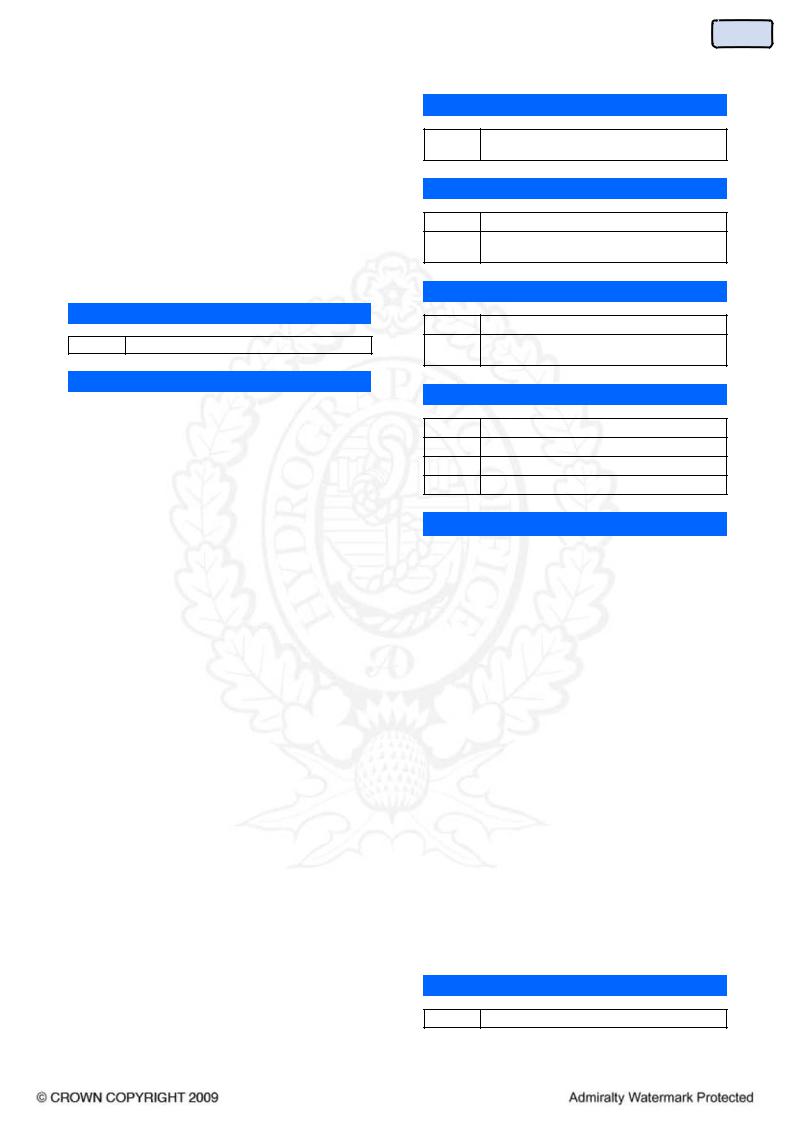
Contents
LIST OF CONTENTS
|
Supply and distribution |
|
|
|
|
2.53 |
Admiralty Distributors |
|
|
|
|
2.54 |
Orders |
|
|
|
|
2.55 |
Chart update services |
|
|
|
|
|
Selection of charts |
|
|
|
|
2.56 |
Chart catalogues |
|
|
|
|
2.57 |
Carriage requirements |
|
|
|
|
2.58 |
Chart folios |
|
|
|
|
State of charts on supply
2.59General information
Upkeep of the paper chart outfit
|
Chart outfit management |
|
|
|
|
2.60 |
Chart outfits |
|
|
|
|
2.61 |
Chart management system |
|
|
|
|
2.62 |
Paper Chart Maintenance Record |
|
|
|
|
2.63 |
Action on receiving a chart outfit |
|
|
|
|
2.64 |
Action on notification of the publication of a |
|
|
New Chart or New Edition |
|
|
|
|
2.65 |
Action on receipt of a New Chart or New |
|
|
Edition |
|
|
|
|
2.66 |
Action on receipt of a chart additional to the |
|
|
outfit |
|
|
|
|
2.67 |
Action on receipt of replacement chart |
|
|
|
|
2.68 |
Action on receipt of a Weekly Edition of |
|
|
Admiralty Notices to Mariners |
|
|
|
Correcting charts |
|
|
|
|
|
2.69 |
|
General information |
|
|
|
|
|
2.70 |
|
Overlay update tracings |
|
|
|
|
|
2.71 |
|
Terms used in updates |
|
|
|
|
|
2.72 |
|
Previous updates |
|
|
|
|
|
2.73 |
|
Detail required |
|
|
|
|
|
2.74 |
|
Alterations |
|
|
|
|
|
2.75 |
|
Blocks |
|
|
|
|
|
2.76 |
|
Completion of updates |
|
|
|
|
|
|
|
|
|
|
Electronic charts and display systems |
|
|
|
|
|
|
|
|
General information |
|
|
|
|
|
2.77 |
|
Introduction |
|
|
|
|
|
2.78 |
|
Chart display systems |
|
|
|
|
|
2.79 |
|
Electronic charts |
|
|
|
|
|
2.80 |
|
Official and unofficial data |
|
|
|
|
|
ECDIS
2.81– See NP 100
2.86
ENCs
2.87General information
2.88– See NP 100
2.97
Admiralty Vector Chart Service (AVCS)
2.98General information
2.99– See NP 100
2.105
Admiralty Raster Chart Service (ARCS)
2.106 General information
2.107 Updating service
2.108 Format
2.109 Service levels
Chapter 3 – Admiralty Publications
|
|
General information |
|
|
|
|
|
3.1 |
|
Availability |
|
|
|
|
|
3.2 |
|
Time used in Admiralty publications |
|
|
|
|
|
|
|
Admiralty Sailing Directions |
|
|
|
|
|
|
|
General information |
|
|
|
|
|
3.3 |
|
Scope |
|
|
|
|
|
3.4 |
|
Currency |
|
|
|
|
|
3.5 |
|
Units of measurement |
|
|
|
|
|
|
|
|
|
|
Maintenance of Sailing Directions |
|
|
|
|
|
|
3.6 |
|
Use of Sailing Directions |
|
|
|
|
|
3.7 |
|
New Editions |
|
|
|
|
|
3.8 |
|
Supplements |
|
|
|
|
|
3.9 |
|
Current editions |
|
|
|
|
|
3.10 |
|
Amendment by Notices to Mariners |
|
|
|
|
|
3.11 |
|
Amendment procedure |
|
Ocean Passages for the World
3.12Contents
4
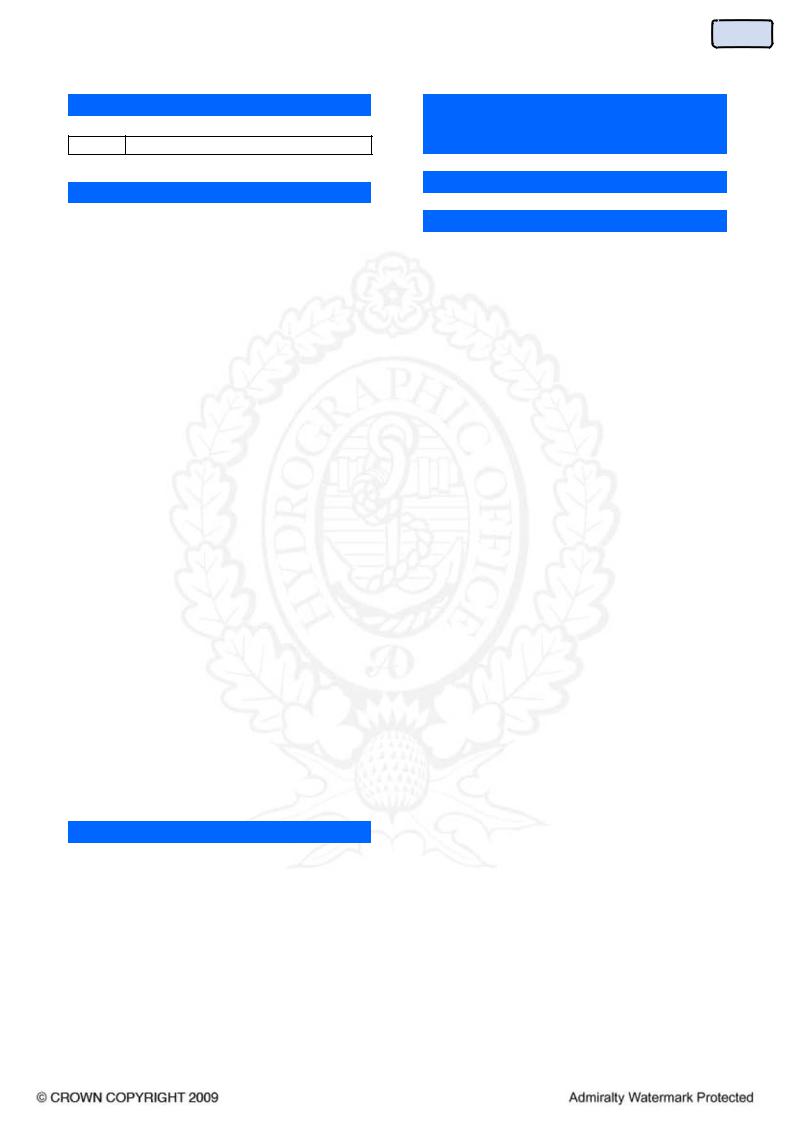
Contents
LIST OF CONTENTS
Admiralty Distance Tables
3.13Contents
Admiralty List of Lights and Fog Signals
3.14 |
Contents |
|
|
3.15 |
Positions |
|
|
3.16 |
Amendment |
|
|
3.17 |
New Editions |
|
|
3.18 |
Admiralty Digital List of Lights |
|
|
|
Admiralty List of Radio Signals |
|
|
|
|
|
|
3.19 |
|
General information |
|
|
|
|
|
3.20 |
|
Volume 1 |
|
|
|
|
|
3.21 |
|
Volume 2 |
|
|
|
|
|
3.22 |
|
Volume 3 |
|
|
|
|
|
3.23 |
|
Volume 4 |
|
|
|
|
|
3.24 |
|
Volume 5 |
|
|
|
|
|
3.25 |
|
Volume 6 |
|
|
|
|
|
3.26 |
|
Amendment |
|
|
Admiralty Tide Tables |
|
|
|
|
3.27 |
Arrangement |
|
|
|
|
3.28 |
Simplified Harmonic Method (SHM) for |
|
|
Windows |
|
|
|
|
3.29 |
Accuracy |
|
|
|
|
3.30 |
Coverage |
|
|
|
|
3.31 |
Amendment |
|
|
|
|
3.32 |
Tidal Stream Atlases |
|
|
|
|
3.33 |
Admiralty TotalTide |
|
|
|
|
3.34 |
Admiralty EasyTide |
|
|
|
|
3.35 |
Other tidal publications |
|
|
|
|
Publications supporting celestial navigation
3.36 |
HM Nautical Almanac Office (HMNAO) |
|
|
3.37 |
The Astronomical Almanac |
|
|
3.38 |
The Nautical Almanac |
|
|
3.39 |
Astronomical Phenomena |
|
|
3.40 |
NavPac and Compact Data |
|
|
3.41 |
Rapid Sight Reduction Tables for Navigation |
|
|
3.42 |
Sight Reduction Tables for Marine |
|
Navigation |
3.43 |
Star Finder and Identifier |
|
|
Chapter 4 – Promulgation of information by and rendering of information to the UKHO
Promulgation of information
Navigationally significant information
4.1 |
General information |
|
|
4.2 |
Selection of navigationally significant |
|
information |
4.3 |
Promulgation |
|
|
4.4 |
Information which is not navigationally |
|
significant |
4.5 |
Sources of information |
|
Navigational Warnings and |
|
|
weather information |
|
|
|
|
4.6 |
Introduction |
|
|
|
|
4.7 |
NAVAREAs |
|
|
|
|
4.8 |
Types of Navigational Warnings |
|
|
|
|
4.9 |
NAVAREA Warnings |
|
|
|
|
4.10 |
Sub–Area Warnings |
|
|
|
|
4.11 |
Coastal Warnings |
|
|
|
|
4.12 |
Local Warnings |
|
|
|
|
4.13 |
Language |
|
|
|
|
4.14 |
International SafetyNET Service |
|
|
|
|
4.15 |
NAVTEX |
|
|
|
|
4.16 |
Updating charts for Navigational Warnings |
|
|
|
|
|
Weather information |
|
|
|
|
4.17 |
World Meteorological Organisation (WMO) |
|
|
|
|
4.18 |
Offshore Shipping Forecast |
|
|
|
|
4.19 |
Gale warnings |
|
|
|
|
4.20 |
High seas – Atlantic Weather Bulletins and |
|
|
Storm Warnings |
|
4.21 |
Coastal Inshore Waters Forecast |
|
|
|
|
4.22 |
Coastal Strong Wind Warnings |
|
|
|
|
4.23 |
Ships’ Weather Reports |
|
|
|
|
4.24 |
Met Office website |
|
|
|
|
|
Admiralty Notices to Mariners |
|
|
|
|
4.25 – |
How Notices to Mariners are promulgated |
|
4.26 |
|
|
|
|
|
4.27 |
Numbering conventions |
|
|
|
|
|
Types of Notices to Mariners |
|
|
|
|
4.28 |
General information |
|
|
|
|
4.29 |
Preliminary Notices to Mariners ((P) NM) |
|
|
|
|
4.30 |
Temporary Notices to Mariners ((T) NM) |
|
|
|
|
5
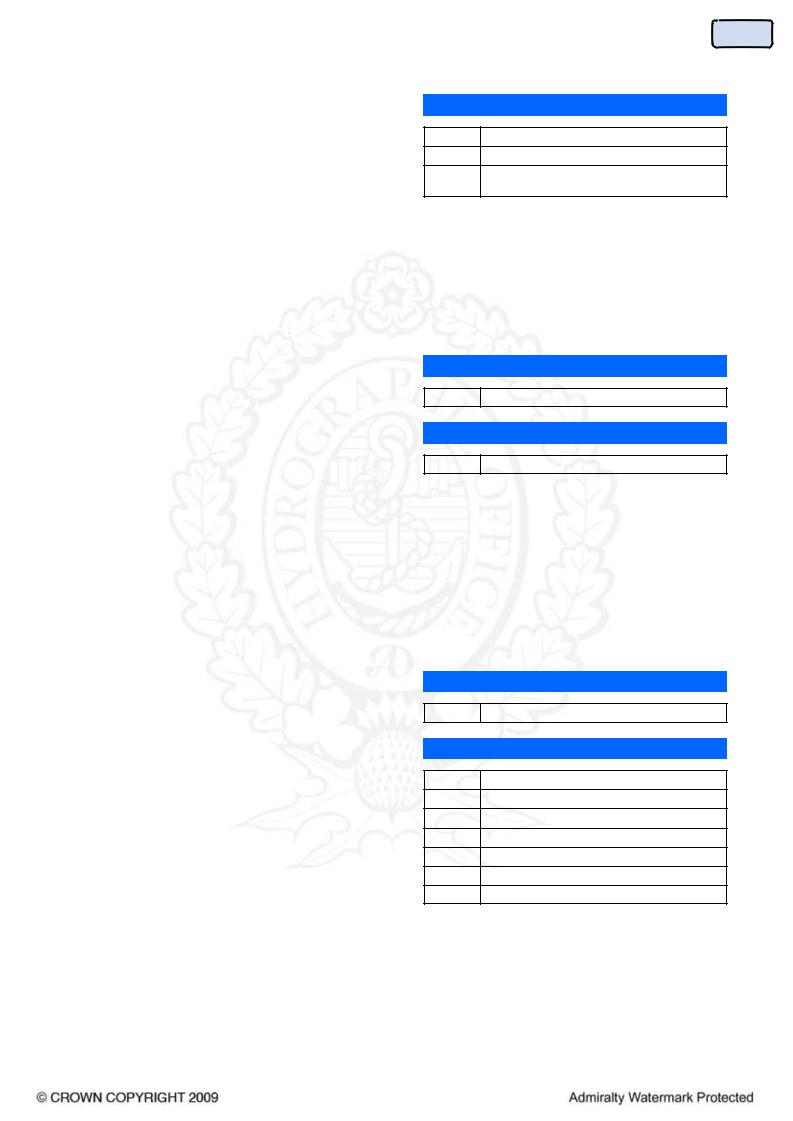
Contents
LIST OF CONTENTS
|
Structure of the Weekly Edition of |
|
|
|
|
Notices to Mariners |
|
|
|
|
|
4.31 |
|
Section I – Explanatory Notes and |
|
|
|
Publications List |
|
|
|
|
|
4.32 |
|
Section II – Updates to Standard |
|
|
|
Navigational Charts |
|
|
|
|
|
4.33 |
|
Section III – Reprints of Navigational |
|
|
|
Warnings |
|
|
|
|
|
4.34 |
|
Section IV – Amendments to Admiralty |
|
|
|
Sailing Directions |
|
|
|
|
|
4.35 |
|
Section V – Amendments to Admiralty Lists |
|
|
|
of Lights and Fog Signals |
|
4.36 |
|
Section VI – Amendments to Admiralty Lists |
|
|
|
of Radio Signals |
|
|
Maintenance of NM data |
|
|
|
|
4.37 |
Retention of back copies |
|
|
|
|
4.38 |
Annual Summary of Admiralty Notices to |
|
|
Mariners |
|
|
|
|
4.39 |
Cumulative List of Admiralty Notices to |
|
|
Mariners |
|
|
|
|
4.40 |
Summary of periodical information |
|
|
|
|
|
Reporting of information |
|
|
|
|
|
Observing and reporting |
|
|
hydrographic information |
|
|
|
|
4.41 |
General remarks |
|
|
|
|
4.42 |
Opportunities for reporting |
|
|
|
|
|
|
|
|
Obligatory reports |
|
|
|
|
4.43 |
Requirements |
|
|
|
|
4.44 |
Standard reporting format and procedures |
|
|
|
|
|
Other forms of report |
|
|
|
|
4.45 |
Hydrographic Note |
|
|
|
|
4.46 |
Information requiring corroboration |
|
|
|
|
|
Positions |
|
|
|
|
4.47 |
Charts |
|
|
|
|
4.48 |
Geographical positions |
|
|
|
|
4.49 |
Astronomical positions |
|
|
|
|
4.50 |
Visual fixes |
|
|
|
|
4.51 |
Fixes from electronic positioning systems |
|
|
|
|
4.52 |
Fixes from GPS |
|
|
|
|
4.53 |
Channels and passages |
|
|
|
|
Soundings
4.54Echo sounder
4.55Trace
4.56– See NP 100
4.58
|
Navigational marks |
|
|
|
|
4.59 |
Lights |
|
|
|
|
4.60 |
Buoys |
|
|
|
|
4.61 |
Beacons and daymarks |
|
|
|
|
4.62 |
Conspicuous objects |
|
|
|
|
4.63 |
Wrecks |
|
Tidal streams
4.64Reporting
Port facilities
4.65General information
|
Offshore reports |
|
|
|
|
4.66 |
Ocean currents |
|
|
|
|
4.67 |
Discoloured water |
|
|
|
|
4.68 |
Bioluminescence |
|
|
|
|
4.69 |
Underwater volcanoes and earthquakes |
|
|
|
|
4.70 |
Whales |
|
|
|
|
4.71 |
Turtles in British waters |
|
|
|
|
4.72 |
Ornithology |
|
Magnetic variation
4.73Reporting
Views
4.74Introduction
4.75Types of view
4.76Panoramic views
4.77Aerial views
4.78Pilotage views
4.79Portrait views
4.80Close–up views
|
Presentation |
|
|
|
|
4.81 |
Quality and composition of views |
|
|
|
|
4.82 |
Annotation |
|
|
|
|
4.83 |
Records |
|
|
|
|
4.84 |
Submission to UKHO |
|
|
|
|
6

Contents
LIST OF CONTENTS
Chapter 5 – The Sea
5.1 – See NP 100
5.11
Tidal streams
5.12Information on charts
5.13Other publications
Tides
Chart Datum
5.14Definition
5.15Datums in use on charts
Tidal charts
5.16See NP 100
Tides in rivers and estuaries
5.17Abnormalities
5.18– See NP 100
5.55
Chapter 6 – Ice
Sea ice (See NP 100 6.1)
Ice of Land Origin (See NP 100 6.13)
Navigation in Ice (See NP 100 6.23)
Material preparations for operations in ice (See NP100 6.36)
Operations in ice (See NP 100 6.56)
Effects on the body of exposure to cold (See NP 100 6.78)
Chapter 7 – Meteorology
General maritime meteorology (See NP 100 7.1) Weather routeing of ships (See NP 100 7.40) Weather related phenomena (See NP 100 7.42)
Chapter 8 –
International Organisations
International |
Maritime |
Organisation |
(IMO) |
(See NP 100 8.1) |
|
|
|
International |
Hydrographic |
Organisation |
(IHO) |
(See NP 100 |
8.6) |
|
|
International Association of Marine Aids to Navigation and Lighthouse Authorities (IALA) (See NP 100 8.13)
Chapter 9 – Constraints on
Navigation
United Nations Convention on the Law of the Sea (UNCLOS) (See NP 100 9.1)
Ships’ Routeing (See NP 100 9.17) Minefields (See NP 100 9.34)
Offshore renewable energy installations (OREI) (See NP 100 9.36)
Submarine pipelines and cables (See NP 100 9.63) Bridges and overhead power cables (See NP 100 9.71)
Chapter 10 – Maritime pollution and conservation (MARPOL)
MARPOL regulations (See NP 100 10.1) Pollution of the sea (See NP 100 10.23) Conservation (See NP 100 10.28)
Chapter 11 – Navigation and
Aids to Navigation
Fixing the position
11.1General information
11.2– See NP 100
11.3
|
Visual fixes |
|
|
|
|
11.4 |
Simultaneous bearings |
|
|
|
|
11.5 |
Simultaneous bearing and distance |
|
|
|
|
11.6 |
Running fix |
|
|
|
|
11.7 |
Transit |
|
|
|
|
11.8 |
Horizontal sextant angles |
|
|
|
|
11.9 |
Vertical sextant angles |
|
|
|
|
Astronomical observation
11.10General information
|
Radar |
|
|
|
|
11.11 |
Fixing |
|
|
|
|
11.12 |
Radar clearing ranges |
|
|
|
|
11.13 |
Parallel index |
|
|
|
|
11.14 |
Radar horizon |
|
|
|
|
11.15 |
Quality and accuracy of radar returns |
|
|
|
|
11.16 |
Radar image enhancement |
|
|
|
|
11.17 |
Overhead power cables |
|
|
|
|
Electronic position–fixing systems
11.18General information
11.19– See NP 100
11.22
7
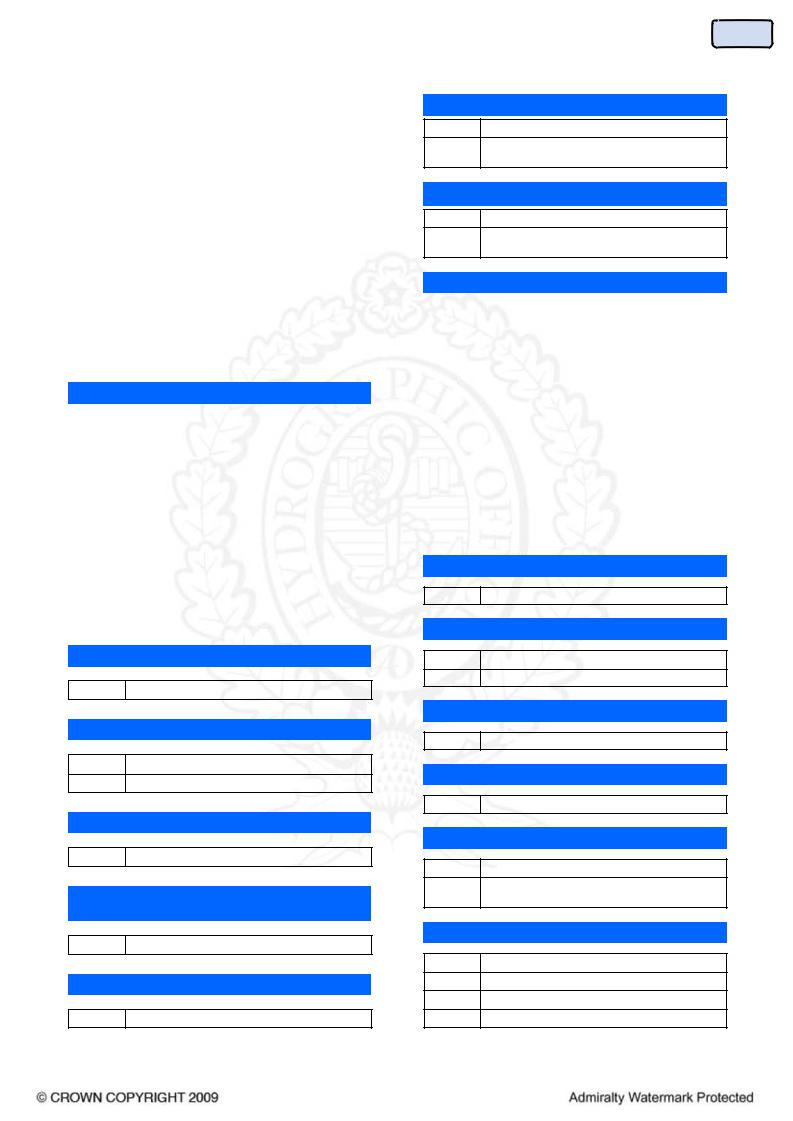
Contents
LIST OF CONTENTS
|
Satellite navigation systems |
|
|
|
|
11.23 |
Global Navigation Satellite Systems (GNSS) |
|
|
|
|
11.24 |
Current Global Navigation Satellite Systems |
|
|
|
|
11.25 |
Proposed Global Navigation Satellite |
|
|
Systems |
|
|
|
|
11.26 |
Other regional navigation systems |
|
|
|
|
11.27 |
GNSS classification |
|
|
|
|
11.28 |
Datum shifts in satellite navigation systems |
|
|
Error sources |
|
|
|
|
11.29 |
General information |
|
|
|
|
11.30– |
See NP 100 |
|
11.35 |
|
|
NAVSTAR Global Positioning System (GPS)
11.36 |
General information |
|
|
11.37 |
Obtaining a position |
|
|
11.38 |
Accuracy |
|
|
11.39 |
Gaps in coverage |
|
|
11.40 |
Supporting information |
|
Differential GPS |
|
|
|
|
11.41 |
Introduction |
|
|
|
|
11.42 |
Principle |
|
|
|
|
11.43 |
Broadcast of corrections |
|
|
|
|
GLONASS
11.44General information
GALILEO
11.45General information
11.46See NP 100
COMPASS
11.47General information
Indian Regional Navigational Satellite System
(IRNSS)
11.48See NP 100
Augmentation systems
11.49Introduction
Satellite based (SBAS)
11.50Introduction
11.51– See NP 100
11.57
Ground–based (GBAS)
11.58Introduction
11.59– See NP 100
11.60
Automatic Identification System (AIS)
|
General information |
|
|
|
|
11.61 |
System description |
|
|
|
|
11.62 |
Function |
|
|
|
|
11.63 |
Mandation |
|
|
|
|
11.64 |
Objectives of AIS |
|
|
|
|
11.65 |
Operation |
|
|
|
|
11.66 |
Operational guidance |
|
|
|
|
11.67 |
AIS data input |
|
|
|
|
11.68 |
Inherent limitations of AIS |
|
|
|
|
11.69 – |
Target information |
|
11.70 |
|
|
11.71 |
AIS in UK waters |
|
Collision avoidance
11.72Use of AIS in collision avoidance
VTS
11.73 Use of AIS in ship reporting
11.74 Mandatory ship reporting systems
Aid to navigation
11.75AIS as an aid to navigation
Search and rescue
11.76AIS in SAR operations
Long–range identification and tracking (LRIT)
11.77General information
11.78– See NP 100
11.82
Lights
11.83Sectors
11.84Ranges
11.85Aero lights
11.86Obstruction lights
8
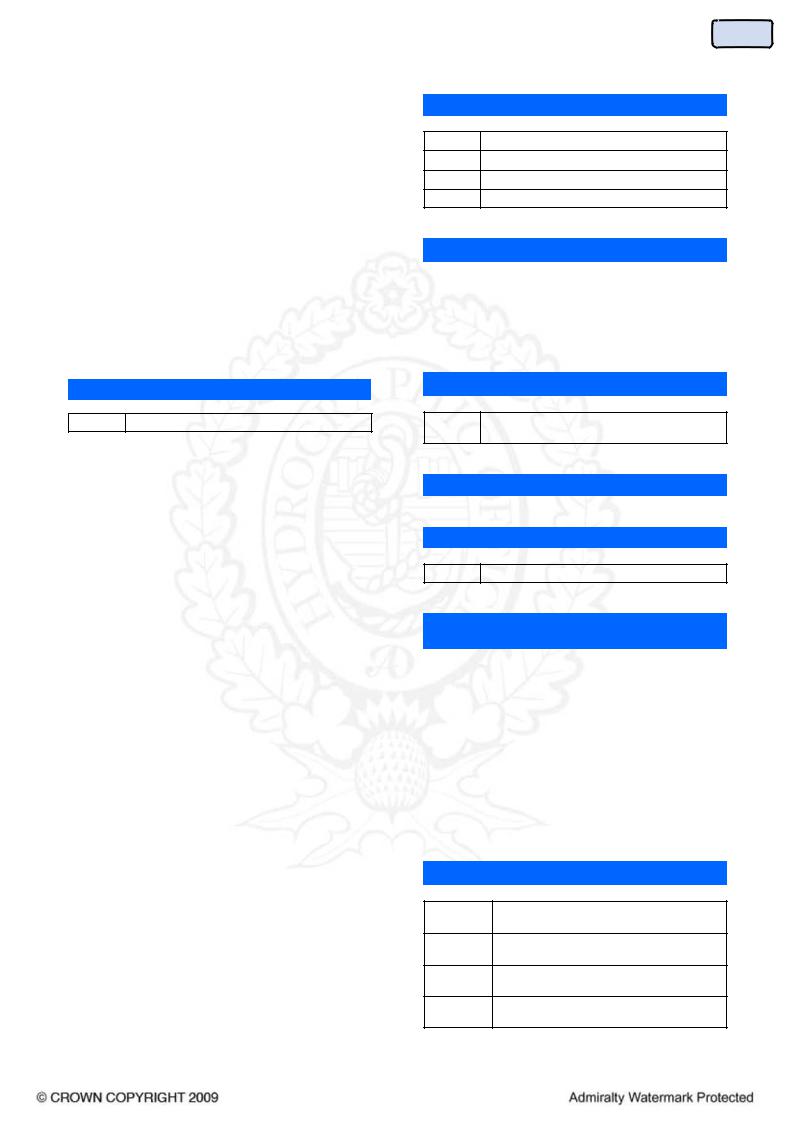
Contents
LIST OF CONTENTS
|
Fog signals |
|
|
|
|
11.87 |
General information |
|
|
|
|
11.88 |
Homing on a fog signal |
|
|
|
|
|
|
|
|
Buoyage |
|
|
|
|
|
General information |
|
|
|
|
11.89 |
Use of moored marks |
|
|
|
|
11.90 |
Pillar buoys |
|
|
|
|
11.91 |
Avoidance |
|
|
|
|
11.92 |
Sound signals |
|
|
|
|
The IALA Maritime Buoyage System
11.93Description
|
Other buoyage |
|
|
|
|
11.94 – |
See NP 100 |
|
11.97 |
|
|
|
|
|
|
Echo soundings |
|
|
|
|
|
Sounders |
|
|
|
|
11.98 |
General information |
|
|
|
|
11.99 |
Transmission line |
|
|
|
|
11.100 |
Velocity of sound |
|
|
|
|
11.101 |
Adjustments to sounder |
|
|
|
|
|
|
|
|
Checking recorded depth |
|
|
|
|
11.102 |
Precision checking |
|
|
|
|
11.103 |
Checking for navigational accuracy |
|
|
|
|
|
False echoes |
|
|
|
|
11.104 |
“Round–the clock” echoes |
|
|
|
|
11.105 |
Double echoes |
|
|
|
|
11.106 |
Multiple echoes |
|
|
|
|
11.107 |
Other false echoes |
|
|
|
|
|
|
|
|
Interaction |
|
|
|
|
11.108 |
Introduction |
|
|
|
|
Under–keel clearance
11.128 Need for precise consideration
11.129 Under–keel Allowance
11.130 Mandated Under–keel Allowance
11.131 Calculation
Chapter 12 – Military Operations
General information (See NP 100 12.1) Exercise areas (See NP 100 12.3) Submarines (See NP 100 12.10)
Mine countermeasures (See NP 100 12.29)
Other military activity at sea (See NP 100 12.33)
Chapter 13 – Commercial Operations
13.1 – See NP 100
13.98
Distress and rescue
General information
13.99Introduction
Global Maritime Distress and Safety System
(GMDSS)
13.100 |
Administration |
|
|
13.101 |
Objectives |
|
|
13.102 |
GMDSS Sea Areas |
|
|
13.103 |
GMDSS equipment |
|
|
13.104 |
Ship reporting systems |
|
|
13.105 |
UK waters |
|
|
13.106 |
Other sources of information |
|
|
13.107– |
See NP 100 |
13.159 |
|
Annexes
Annex A Requirements for the Carriage of Charts and Publications (See NP 100)
Annex B The International Rules for Preventing Collisions at Sea (See NP 100)
Annex C IALA Maritime Buoyage System (See
NP 100)
Annex D Flags and Ensigns of Maritime Nations (See NP 100)
9
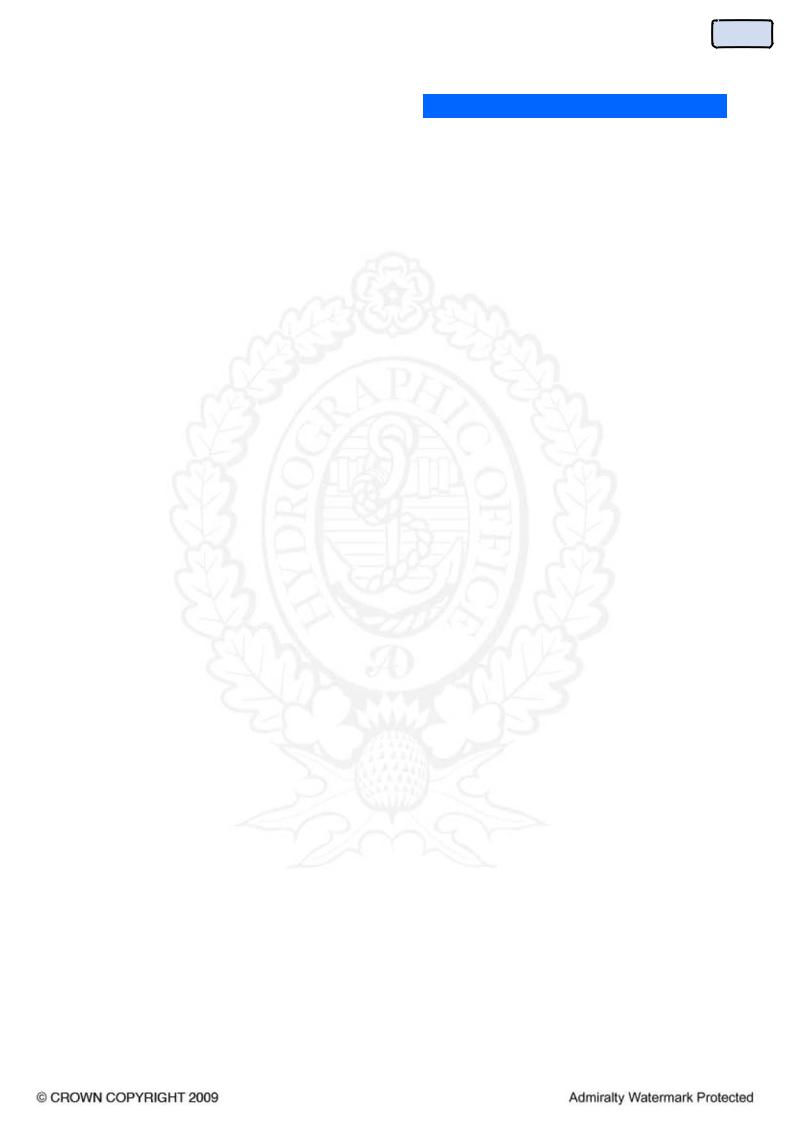
Contents
LIST OF CONTENTS
|
Glossaries |
|
|
|
|
Glossary |
Terms used on Admiralty Charts and in |
|
|
associated publications (See NP 100) |
|
|
|
|
Ice |
Terms commonly used in an ice |
|
Glossary |
environment (See NP 100) |
|
Supplementary tables
Conversion tables for temperatures, pressures, distances and depths (See NP 100)
10
